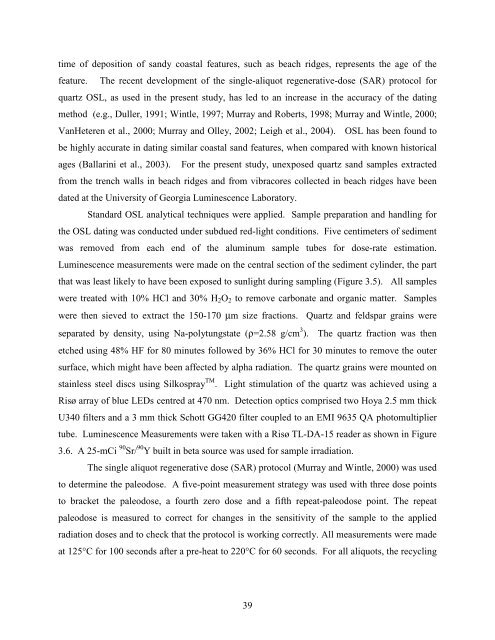the florida state university college of arts and sciences evolution of ...
the florida state university college of arts and sciences evolution of ...
the florida state university college of arts and sciences evolution of ...
You also want an ePaper? Increase the reach of your titles
YUMPU automatically turns print PDFs into web optimized ePapers that Google loves.
time <strong>of</strong> deposition <strong>of</strong> s<strong>and</strong>y coastal features, such as beach ridges, represents <strong>the</strong> age <strong>of</strong> <strong>the</strong><br />
feature. The recent development <strong>of</strong> <strong>the</strong> single-aliquot regenerative-dose (SAR) protocol for<br />
quartz OSL, as used in <strong>the</strong> present study, has led to an increase in <strong>the</strong> accuracy <strong>of</strong> <strong>the</strong> dating<br />
method (e.g., Duller, 1991; Wintle, 1997; Murray <strong>and</strong> Roberts, 1998; Murray <strong>and</strong> Wintle, 2000;<br />
VanHeteren et al., 2000; Murray <strong>and</strong> Olley, 2002; Leigh et al., 2004). OSL has been found to<br />
be highly accurate in dating similar coastal s<strong>and</strong> features, when compared with known historical<br />
ages (Ballarini et al., 2003). For <strong>the</strong> present study, unexposed quartz s<strong>and</strong> samples extracted<br />
from <strong>the</strong> trench walls in beach ridges <strong>and</strong> from vibracores collected in beach ridges have been<br />
dated at <strong>the</strong> University <strong>of</strong> Georgia Luminescence Laboratory.<br />
St<strong>and</strong>ard OSL analytical techniques were applied. Sample preparation <strong>and</strong> h<strong>and</strong>ling for<br />
<strong>the</strong> OSL dating was conducted under subdued red-light conditions. Five centimeters <strong>of</strong> sediment<br />
was removed from each end <strong>of</strong> <strong>the</strong> aluminum sample tubes for dose-rate estimation.<br />
Luminescence measurements were made on <strong>the</strong> central section <strong>of</strong> <strong>the</strong> sediment cylinder, <strong>the</strong> part<br />
that was least likely to have been exposed to sunlight during sampling (Figure 3.5). All samples<br />
were treated with 10% HCl <strong>and</strong> 30% H2O2 to remove carbonate <strong>and</strong> organic matter. Samples<br />
were <strong>the</strong>n sieved to extract <strong>the</strong> 150-170 μm size fractions. Quartz <strong>and</strong> feldspar grains were<br />
separated by density, using Na-polytung<strong>state</strong> (ρ=2.58 g/cm 3 ). The quartz fraction was <strong>the</strong>n<br />
etched using 48% HF for 80 minutes followed by 36% HCl for 30 minutes to remove <strong>the</strong> outer<br />
surface, which might have been affected by alpha radiation. The quartz grains were mounted on<br />
stainless steel discs using Silkospray TM . Light stimulation <strong>of</strong> <strong>the</strong> quartz was achieved using a<br />
Risø array <strong>of</strong> blue LEDs centred at 470 nm. Detection optics comprised two Hoya 2.5 mm thick<br />
U340 filters <strong>and</strong> a 3 mm thick Schott GG420 filter coupled to an EMI 9635 QA photomultiplier<br />
tube. Luminescence Measurements were taken with a Risø TL-DA-15 reader as shown in Figure<br />
3.6. A 25-mCi 90 Sr/ 90 Y built in beta source was used for sample irradiation.<br />
The single aliquot regenerative dose (SAR) protocol (Murray <strong>and</strong> Wintle, 2000) was used<br />
to determine <strong>the</strong> paleodose. A five-point measurement strategy was used with three dose points<br />
to bracket <strong>the</strong> paleodose, a fourth zero dose <strong>and</strong> a fifth repeat-paleodose point. The repeat<br />
paleodose is measured to correct for changes in <strong>the</strong> sensitivity <strong>of</strong> <strong>the</strong> sample to <strong>the</strong> applied<br />
radiation doses <strong>and</strong> to check that <strong>the</strong> protocol is working correctly. All measurements were made<br />
at 125°C for 100 seconds after a pre-heat to 220°C for 60 seconds. For all aliquots, <strong>the</strong> recycling<br />
39

















